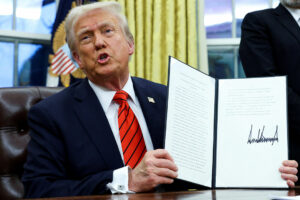THE Philippines’ trade position with the US should help insulate it from global trade uncertainties, S&P Global Ratings said.
“Fortunately for the Philippines, it is one of the major economies, perhaps the only major economy that we know of in the region, that actually has a trade surplus with the US,” YeeFarn Phua, director at S&P Global Ratings, said in a webinar on Tuesday.
The US is the top destination for Philippine-made goods. In 2024, exports to the US were valued at $12.12 billion or 16.6% of total export sales.
On the other hand, the value of imports from the US stood at $8.17 billion or 6.4% of total imports.
“For now, when it comes to talking about tariffs on certain countries in this region, I think the Philippines has not come up in the equation in the meantime,” Mr. Phua said.
US President Donald J. Trump has ordered a slew of tariffs on Chinese imports, is reviewing duties on Mexico and Canada, and announced a 25% tariff on all steel and aluminum imports from any source.
Mr. Trump also signaled reciprocal tariffs on all countries that charge duties on US imports.
Mr. Phua said there could be potential benefits to the Philippines from the second-round effects resulting from such tariffs, but it is too early to tell.
“Whether the Philippines gets to enjoy that, I think it really depends on what kind of sectors we’re talking about and what kind of tariffs are being imposed.”
Markets are still in wait-and-see mode on how exactly Mr. Trump plans to implement his tariff proposals.
“We can assume that if you’re talking about something more high-tech, very cutting-edge technology, perhaps the Philippines will not be in a position at this moment to benefit,” he said.
“But you’re talking about some of the products down the value chain, like assembly, packaging, and so on, of electronic goods. Perhaps there could be some advantages for the Philippines in the sense that it will see some of the production going to the Philippines.”
This could boost foreign direct investment as well as overall economic growth, he added.
However, Mr. Phua said the effects from these trade policies are unlikely to impact the Philippine credit rating.
“Having said that, these are largely not key factors for us to look for in terms of the upgrade for the Philippines,” Mr. Phua said.
“As we stated in our outlook statement for the Philippines, we are really looking at two factors here. First is the continued building of external buffers. The second is the continued consolidation of its fiscal position,” he added.
In November, S&P Global affirmed the Philippines’ investment-grade rating and raised its outlook to “positive” from “stable.”
The credit rater is monitoring the Philippine current account deficit, Mr. Phua said.
“We have seen the current account deficit start to widen, and that in turn has started to shave down some of the external buffers that the Philippines currently has.
“We are looking to see the Philippines maintain the current account deficits at a moderate level and to rebuild those external buffers before the ratings could then be upgraded,” he added.
This year, the central bank expects the current account deficit to widen to $12.1 billion, or 2.4% of GDP.
“At the same time, we think the slower pace of fiscal consolidation announced by the government over the medium-term fiscal framework last year is more realistic,” Mr. Phua said. — Luisa Maria Jacinta C. Jocson

